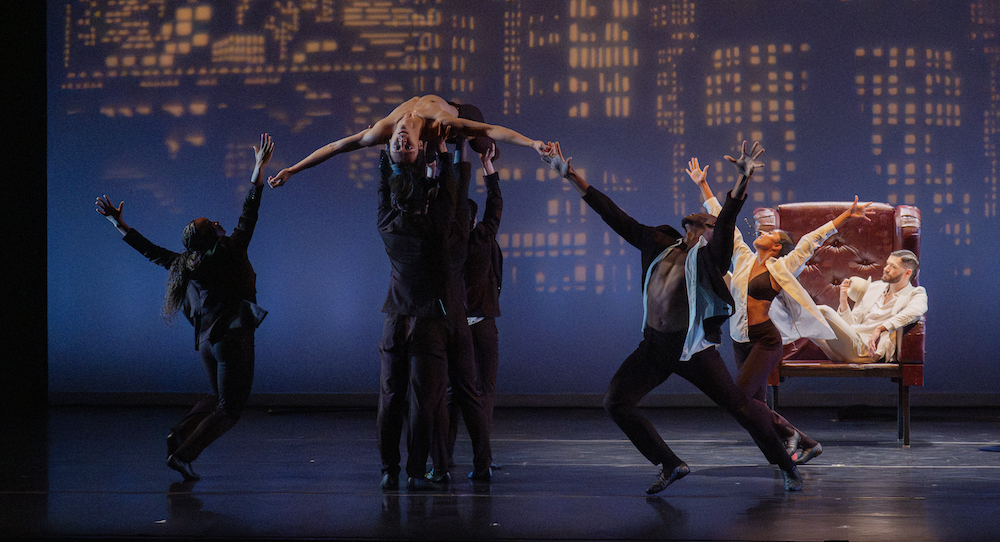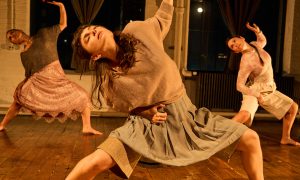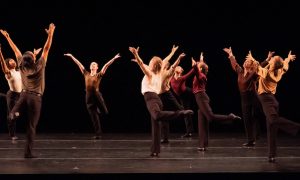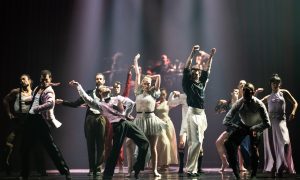The Joyce Theater, New York, NY.
October 16, 2025.
In celebration of its 80th anniversary, the Limón Dance Company performed a mixed program of old repertory and a new work by Diego Vega Solorza, a Mexican choreographer known for bridging the visual arts with dance, at the Joyce Theater.
Chaconne (1942), set to Bach’s “Chaconne” with live music by John Marcus on violin, was performed by a wide mix of dancers from the past and present, including Limón2, company alumni, students, and older dancers who had performed with the company at some point. Dancers were grouped in quartets, sextets, duets and solos. The choreography, a series of turns with variations in arm movement, was suitable for the wide range of movers on stage. Wearing simple tops of different colors and black pants, the piece featured repeated patterns of swirling turns, accompanied by a piqué step with a retiré — in which the foot was brought up to the back of the calf — as dancers stepped forward and flowed across the stage. Limón’s gestural vocabulary and presentational nature supported the older dancers, who performed the port de bras with fluidity.
The Emperor Jones (1956), inspired by Eugene O’Neill’s play about race, power and colonialism, is aptly re-conceived here. The original, set on a Caribbean island, is now set against the backdrop of a cityscape (Peta McKenna) which inferences the theme of capitalism. Jones (performed by Johnson Guo) is the emperor of the boardroom instead of an island. The choreography suggests a man of power, and Maria Talan de la Rosa’s costume design has Guo wearing a large, holstered gun which hangs between his legs.
While sitting in an enormous chair, the gun dangles, and the movement is choreographed with lots of wide-legged movement and walks with the chest puffed out and arms splayed to the side. Coupes and extensions are performed with the torso held straight and facing forward. At another point, in second position, the knees knock in and out. A battement is performed in parallel to the side while the arms are thrust forward in a mechanical manner rather than gliding forward as a port de bras is often executed, all emphasizing Jones’s masculine prowess.
The ensemble — performed by Ian Debona, Stephen Haley, Ty Morrison, Olivia Mozie, Deepa Liegel and Savannah Spratt in black suit pants and white button-up shirts — moves like an ensuing tidal wave, building with each step as they take up more and more space and eventually overcome Jones. It’s “The Man in White” (performed by Joey Columbus), however, who usurps Jones’s power in the end.
In the program notes, it is suggested that a queer subtext is brought to the forefront in this rendering. While the homoerotic parlay between “The White Man” and Jones is suggested, there’s a lot to be read between the presentational lines of Limón’s choreography to feel any real heat between the two characters; at best, they appear as rivals. In this rendition, the lush jungle of O’Neill’s play, explored in Limón’s original piece, is replaced by the stark cityscape, giving the piece the air of a boardroom where one can imagine the characters after hours in an empty high-rise office, fighting over who is the best hedge fund manager.
In the final piece, Jamelgos choreographed by Diego Vega Solorza with a score by Ebe Oko, there is some initial heat between two dancers because they are naked or nearly naked. The piece opens with a naked male dancer dangling from a pole. He drops to the floor where another male dancer lies splayed like a crucified Jesus. The hanging dancer mounts the other, who slowly rises from the floor, shouldering the naked dancer — groin to face — and carries him off.
The piece takes a turn. The ensemble — Johnson Guo, Ty Morrison, Savannah Spratt and Lauren Twomley (the cast shifted each night) — in Julio César Delgado’s costumes, which are reminiscent of Roman warriors but with a fetishistic twist, perform at first slowly; the choreography resembles a balletic tai chi. In leather caps with white ponytails that look like manes, the movement picks up, and dancers perform in lockstep. With quick turns, the tails on the heads and butt pieces fly around in a flurry of white and cascade down around the dancers when they slow down.
There is no clear narrative in Jamelgos; instead, it is best enjoyed for its sensual muscularity. Corey Whittemore’s lighting, which casts the dancers half in shadow and half in light, does a spectacular job of highlighting every muscle on their bodies. The horse theme doesn’t present itself as overly homoerotic (although one might think of Peter Shaffer’s play Equus, which explores a young man’s pathological religious fascination with horses and confusion between “God” and sexual attraction), but it certainly has an erotic feeling. The dancers appear as beautifully chiseled specimens. Are they satyrs? Is this cosplay? The beauty of the choreography and costuming is the room it gives to overlay any interpretation your imagination allows.
By Nicole Colbert of Dance Informa.















